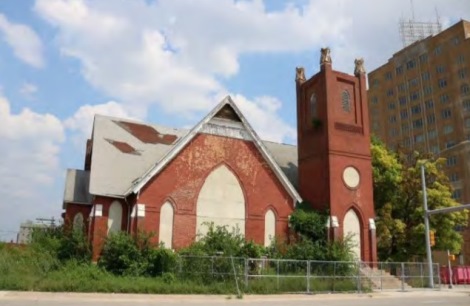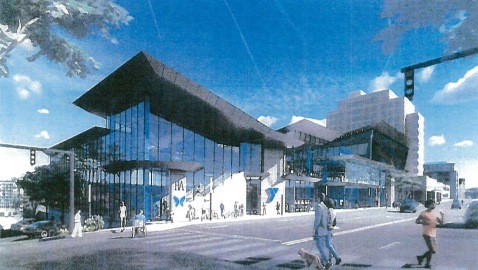BPU considers $250,000 donation to campus project tonight


by Mary Rupert
A landmark Kansas City, Kansas, church could be torn down to make way for the Kansas City Kansas Community College’s $70 million downtown campus project.
Funding for the project is coming from diverse sources, with the Board of Public Utilities being asked at its meeting tonight to contribute $250,000.
On Monday, Nov. 1, the Unified Government’s Landmarks Commission voted to give a certification of appropriateness to demolish the Seventh Street Methodist Episcopal Church, a vacant church building at 7th and State, currently owned by the UG. It was constructed in 1888.
The church at 1101 N. 7th St. is a historic site, listed on the UG’s landmarks list. The UG planning staff recommended denial of demolition, wanting measures to be taken to save the building or parts of it, or wanting to incorporate a restored landmark into the college project. According to planning documents, these other alternatives could have included preservation, rehabilitation, relocation or reconstruction.
Gunnar Hand, UG director of planning, said the certification from Nov. 1 still had some conditions that have to be met before the church can be demolished.
For example, one of the five conditions is to document the building, prepare a full historical structure report. Since the church was not a state or federally designated landmark, only a local landmark, more comprehensive information will be required to make sure there is a lot of material for posterity, he said. They found very little documentation on the church’s history itself, he said.
Another condition will be that they cannot pull a permit for demolition until they reach their funding goals, Hand said. A review process will take place before they will receive the permit. A worst-case scenario would be that a historic landmark could be demolished, and the project not have enough funding to go forward, he said.
The issue could move to the UG Commission sometime in the next month.
A change to the local landmarks ordinance also is in the works. The change has a 200-foot provision, lessening the space between a historic landmark and another structure that would have to be heard by the Landmarks Commission. Historic landmarks owned by the local government would have to have a determination that all other alternatives were exhausted before demolition.
For the college’s project, there were five properties, including four others that were not historic properties, that had to go through the determination process for demolition, as they were close to the historic property.
Those other buildings were altered over the course of history, one with serious fire damage, and over time lost their historical significance, he said.
Hand said there was some difficulty tracking the title history on the church at 7th and State. It was last known to be bought by a Hispanic church, was used for a few years, then went bankrupt and into a tax sale. No one bought it, and it became a Land Bank property, he said. At one time it was believed to be the site of an African-American congregation. For most of the church’s history, descendants of the Wyandots, the founders of the town, were church members.
At the September public hearing, there were two or three community members who spoke out against demolition, while at the November hearing, there were several speaking in favor of the college’s downtown campus plan and demolition.
According to one Landmarks Commission member, the estimate would have been $5.5 million to restore the church, and the commission was told that did not fit in with what the college was trying to do.
One of the Landmark commissioners remarked that the cost of the decision for appropriateness is immaterial when it comes to an irreplaceable landmark – the church is the last standing example of High Victorian Gothic architecture here.
“We believe it is the last Victorian Gothic structure in the UG, one of the last few in the region,” Hand said.
It is one of the last remaining buildings from the expansion of Kansas City, Kansas, from 1886 to 1893, he said.
Parts of the old church, including some foundation stones, six to eight pews, stained glass pieces, two trusses and 20 percent of the red bricks, will be saved from the church and incorporated into the new downtown campus design, according to planning documents. But the building itself will not stand, if the demolition plan moves forward.
Who were the founders of the church?
Who were the founders of the Seventh Street Methodist Episcopal Church? Most likely, they were the same as the founders of the town of Wyandotte, one of the cities that consolidated into Kansas City, Kansas. The Wyandots came here from Ohio, seeking a place to live, and purchased land from the Delawares.
According to Perl Morgan’s 1911 “History of Wyandotte County,” there were 110 members of the original Methodist Episcopal church organized in 1843 in Wyandotte. Forty-one of them joined the Southern branch in October 1848. Pre-Civil War strife split the church, and local churches were burned.
The Methodist Episcopal Church, South, received a lot at the northwest corner of the old Huron Cemetery in 1859, and a church was built there in the 1870s. The property was sold to commercial interests in 1889, and then the congregation erected the church at 7th and State Avenue, according to Morgan. (See more at https://www.ksgenweb.org/archives/wyandott/history/1911/volume1/343.html#034801)
The Wyandots suffered significant illness and death when they first moved here; 60 persons died in the early days.
According to a KCK historic landmarks paper written in 1986, Eliza (Lyda) Conley and Helena Conley were members of this church in the early 1900s. They were involved in one of the most famous historic episodes in Kansas City, Kansas, the defense of the Huron Cemetery against commercial encroachment. The sisters set up a makeshift fort, not allowing anyone onto the cemetery property.
In order to defend the cemetery, Lyda Conley, an attorney and church member, became one of the first women ever to argue a case before the U.S. Supreme Court. Conley did not win her case, but later, U.S. Sen. Charles Curtis of Kansas came to the local Wyandots’ assistance, changing the federal law that would have allowed the sale of the cemetery.
With declining membership, the congregation sold the church to a different congregation in 1986, according to the KCK landmarks paper.
BPU considers giving $250,000 grant to KCKCC downtown campus project
The Board of Public Utilities for the past few months has discussed giving a $250,000 economic development grant to the KCKCC downtown campus project.
The funding is on the BPU agenda again for tonight. No action was taken at its last meeting, with BPU officials wanting to wait a few weeks to find out if the project would be “all-electric,” which would follow the BPU’s economic development fund guidelines.
It might be possible that some science classrooms might need Bunsen burners, BPU officials said.
The college originally asked the BPU for $3 million, either in cash or in-kind donations, to help build the new campus. Some funding could be added in later years, according to BPU officials, if the board approves it.
The college has been promoting the new campus for a few years, with the idea to break the cycle of generational poverty in eastern Kansas City, Kansas.
The college’s downtown campus would be returning to its eastern roots, as it originally started near the same location as part of the old Kansas City, Kansas, High School, a predecessor to Wyandotte High School. In the early 1970s, KCKCC moved to 72nd and State Avenue, near the population center of the city.
Besides funds from the BPU, the college cited community service tax credits from the Kansas Department of Commerce, as a significant source of income, and several other sources.
The $250,000 in the BPU’s economic development fund would not be given to the college immediately, BPU General Manager Bill Johnson said at a BPU recent meeting, but would stay in the BPU economic development fund until later, possibly next year. It would not be disbursed before Dec. 31, he said in answer to a board member’s question.
Johnson recommended giving $250,000 to the college’s downtown campus project at a recent meeting.
BPU board members discussed the possibility of giving grants to agencies that are planning to locate at the new KCKCC downtown campus, such as a health clinic. The college would make up 60 percent of the development, with other agencies including a health clinic and credit union, the other 40 percent, according to BPU officials.
Ryan Eidson, a BPU board member, at the last board meeting questioned whether the board should do that, as some of the agencies might be more designed to make a profit than the college.
Mary Spangler of the KCKCC Foundation spoke at the last BPU meeting and said that students dually enrolled in the Kansas City, Kansas, Public Schools as juniors and seniors, could participate in workforce development there.
Services from Swope Health such as a primary health clinic, children’s health, dental services, emergency dental, women’s health, would be available to serve low-income and underserved populations.
Information submitted from KCKCC to the BPU stated that the new 129,893-square-foot community education center would have four other nonprofit partners, including the YMCA of Greater Kansas City, the University of Kansas, Wyandot Behavioral Health Network and Swope Health.
“The effort will return the College to its roots, placing the Center where those most in need can be served,” the college stated in its questionnaire for BPU funding.
The college’s modified request for BPU funding in September stated that when the workforce training programs are moved to the new downtown community education center, then the college’s Technical Education Center at 65th and State Avenue could begin a utility lineman training program, with adjacent green space used as a pole yard. The college has been in preliminary discussions with the BPU about the new training area.
In September, the college did not yet have estimates on how much electricity and water the new facility downtown would use.
Also in September, the downtown campus project was considered to have met 46 percent of its $70 million goal, according to information the college submitted to BPU.
That included $10 million from KCKCC; $10 million from the Sunderland Foundation; $3 million from Community America Credit Union, $1.72 million from private philanthropy, alumni and individuals; $197,500 from state of Kansas community service tax credits; $2 million from community project funds through Rep. Sharice Davids; and $5 million from federal Economic Development Administration funds, projected in February 2022; according to information the college provided the BPU.
BPU board members asked for more information about how the downtown campus idea, to break generational poverty in the eastern half of the city, would work with each component that will locate there.
The idea of giving $250,000 to the college’s downtown campus had general support from the BPU at the last meeting, but there were still questions the board wanted answered.
The college’s downtown campus project has wide support already lined up, with the college submitting letters of support for the Kansas tax credit to the BPU from leaders including Mayor David Alvey, Tom Burroughs and David Haley.
